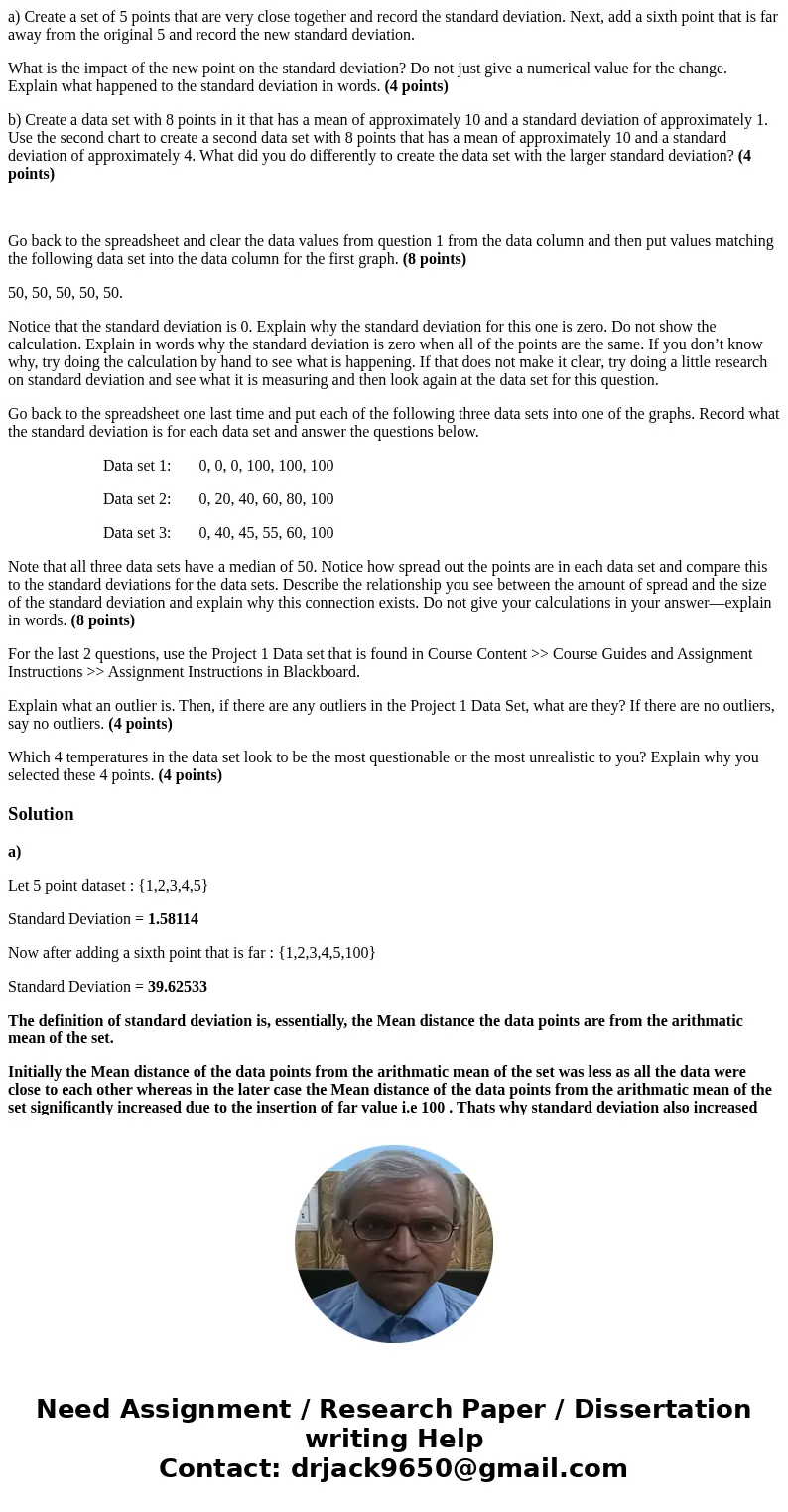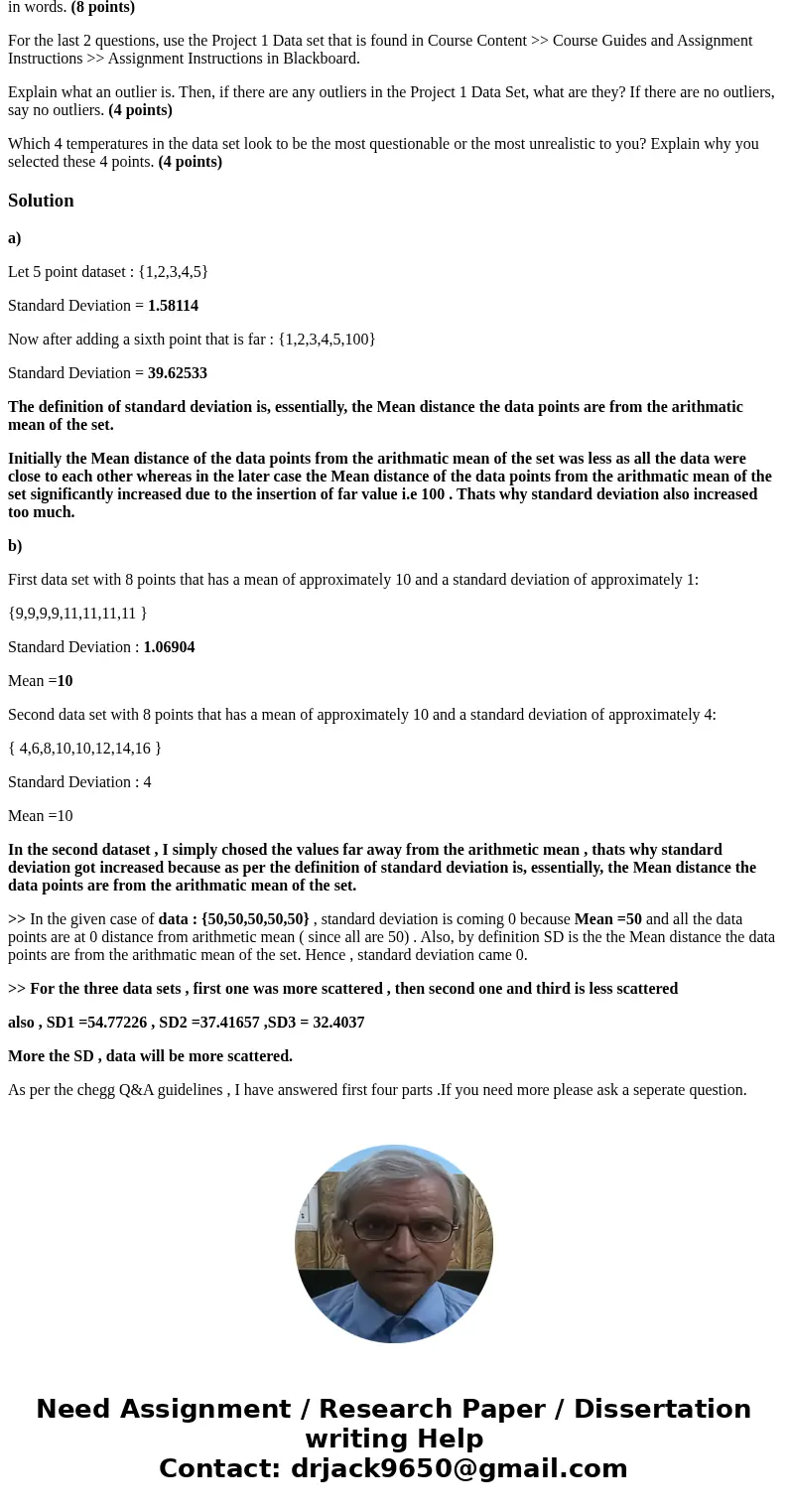a Create a set of 5 points that are very close together and
a) Create a set of 5 points that are very close together and record the standard deviation. Next, add a sixth point that is far away from the original 5 and record the new standard deviation.
What is the impact of the new point on the standard deviation? Do not just give a numerical value for the change. Explain what happened to the standard deviation in words. (4 points)
b) Create a data set with 8 points in it that has a mean of approximately 10 and a standard deviation of approximately 1. Use the second chart to create a second data set with 8 points that has a mean of approximately 10 and a standard deviation of approximately 4. What did you do differently to create the data set with the larger standard deviation? (4 points)
Go back to the spreadsheet and clear the data values from question 1 from the data column and then put values matching the following data set into the data column for the first graph. (8 points)
50, 50, 50, 50, 50.
Notice that the standard deviation is 0. Explain why the standard deviation for this one is zero. Do not show the calculation. Explain in words why the standard deviation is zero when all of the points are the same. If you don’t know why, try doing the calculation by hand to see what is happening. If that does not make it clear, try doing a little research on standard deviation and see what it is measuring and then look again at the data set for this question.
Go back to the spreadsheet one last time and put each of the following three data sets into one of the graphs. Record what the standard deviation is for each data set and answer the questions below.
Data set 1: 0, 0, 0, 100, 100, 100
Data set 2: 0, 20, 40, 60, 80, 100
Data set 3: 0, 40, 45, 55, 60, 100
Note that all three data sets have a median of 50. Notice how spread out the points are in each data set and compare this to the standard deviations for the data sets. Describe the relationship you see between the amount of spread and the size of the standard deviation and explain why this connection exists. Do not give your calculations in your answer—explain in words. (8 points)
For the last 2 questions, use the Project 1 Data set that is found in Course Content >> Course Guides and Assignment Instructions >> Assignment Instructions in Blackboard.
Explain what an outlier is. Then, if there are any outliers in the Project 1 Data Set, what are they? If there are no outliers, say no outliers. (4 points)
Which 4 temperatures in the data set look to be the most questionable or the most unrealistic to you? Explain why you selected these 4 points. (4 points)
Solution
a)
Let 5 point dataset : {1,2,3,4,5}
Standard Deviation = 1.58114
Now after adding a sixth point that is far : {1,2,3,4,5,100}
Standard Deviation = 39.62533
The definition of standard deviation is, essentially, the Mean distance the data points are from the arithmatic mean of the set.
Initially the Mean distance of the data points from the arithmatic mean of the set was less as all the data were close to each other whereas in the later case the Mean distance of the data points from the arithmatic mean of the set significantly increased due to the insertion of far value i.e 100 . Thats why standard deviation also increased too much.
b)
First data set with 8 points that has a mean of approximately 10 and a standard deviation of approximately 1:
{9,9,9,9,11,11,11,11 }
Standard Deviation : 1.06904
Mean =10
Second data set with 8 points that has a mean of approximately 10 and a standard deviation of approximately 4:
{ 4,6,8,10,10,12,14,16 }
Standard Deviation : 4
Mean =10
In the second dataset , I simply chosed the values far away from the arithmetic mean , thats why standard deviation got increased because as per the definition of standard deviation is, essentially, the Mean distance the data points are from the arithmatic mean of the set.
>> In the given case of data : {50,50,50,50,50} , standard deviation is coming 0 because Mean =50 and all the data points are at 0 distance from arithmetic mean ( since all are 50) . Also, by definition SD is the the Mean distance the data points are from the arithmatic mean of the set. Hence , standard deviation came 0.
>> For the three data sets , first one was more scattered , then second one and third is less scattered
also , SD1 =54.77226 , SD2 =37.41657 ,SD3 = 32.4037
More the SD , data will be more scattered.
As per the chegg Q&A guidelines , I have answered first four parts .If you need more please ask a seperate question.


 Homework Sourse
Homework Sourse